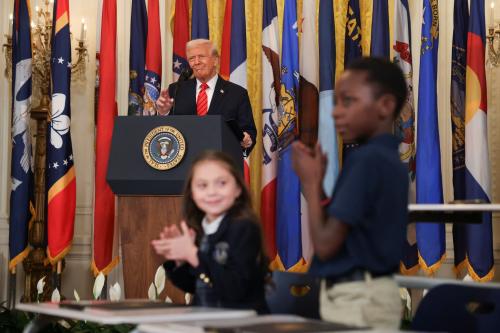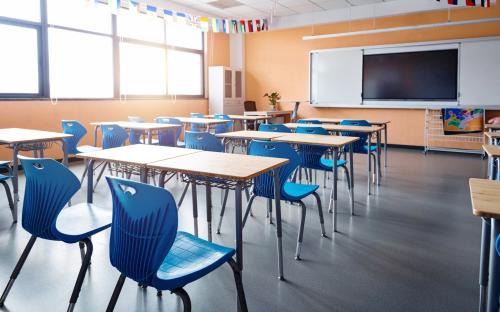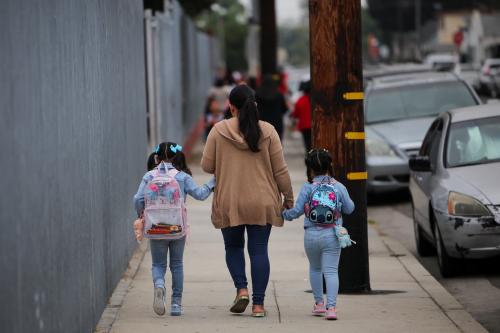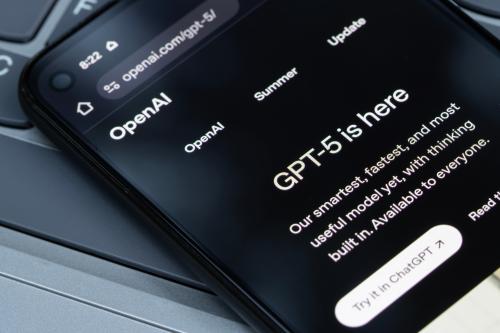At least 1.4 million school-aged children in the United States are experiencing homelessness, living in urban, suburban, and rural communities alike. While homelessness is not new, it is becoming an increasingly common reality for children and youth as more families struggle with rising economic instability. In this context, the protections and resources that federal law has guaranteed to these students for nearly 40 years play an essential role in guaranteeing their adequate access to education. Should the president’s FY2026 budget proposal be enacted by Congress, how would that change, and what would be the potential impact on the homeless student community?
The Education for Homeless Children and Youth (EHCY) program, authorized under Subtitle VII-B of the McKinney-Vento Homeless Assistance Act, requires state and local educational agencies to remove barriers to the identification, enrollment, and success of students experiencing homelessness. Since its bipartisan enactment in 1987, the law has provided critical protections and funding to ensure educational access and stability. The McKinney-Vento Act grants students the right to:
- Enroll in school immediately, even without typically required documents
- Stay in the same school despite residential instability
- Receive transportation assistance to maintain school attendance
- Access support from school district homeless liaisons
Of these core components, the role of the school district homeless liaison is especially critical. Every school district designates a liaison responsible for identifying and enrolling homeless children and youth, arranging transportation, and ensuring access to educational services. Liaisons also train school staff—including bus drivers, enrollment personnel, cafeteria workers, counselors, coaches, teachers, and administrators—on how to recognize and support students experiencing homelessness. They connect young children to early childhood programs and help unaccompanied youth obtain the documentation needed for federal financial aid. By coordinating with community agencies—such as shelters, housing programs, health care providers, and recovery services—liaisons help leverage both public and private resources. In short, school district liaisons are the linchpin that turns the protections of the EHCY program into tangible support for the students who need them most.
The president’s FY2026 budget proposal eliminates dedicated funding for the EHCY program, including for these liaisons. It would roll the funding into a broader block grant with 17 other education initiatives while cutting the total funding for those programs by 70%—from $6.5 billion to $2 billion. This new structure neither requires states to spend funds on students experiencing homelessness nor preserves the legal protections currently provided under McKinney-Vento.
To assess the potential impact of this change, a recent review by SchoolHouse Connection examined state education laws and regulations across all 50 states, the District of Columbia, Puerto Rico, and the Bureau of Indian Education. The findings are stark: The vast majority of states rely entirely on federal McKinney-Vento provisions to protect and support homeless students. Only three states have laws that independently provide all core protections, and only seven offer any state funding for homeless education services.
Eliminating McKinney-Vento protections and dedicated funding would have real implications for some of the country’s most vulnerable students. Students experiencing homelessness already face significant educational challenges. They are more likely to be chronically absent and less likely to graduate high school than their housed peers—even when compared to those living in poverty. This increases their risk of homelessness as young adults, with research showing the lack of a high school degree or equivalent being the single greatest risk factor. Without school district homeless liaisons to identify students experiencing homelessness and coordinate their enrollment and attendance, many of these students might not attend school at all. This could leave them at significantly higher risk for harm, exploitation, and predation.
But research shows that targeted funding makes a difference. An evaluation of American Rescue Plan funds specifically allocated to homeless students (ARP-HCY) found that districts receiving this support identified 25% more homeless students and saw improvements in attendance, academic achievement (reading, math, and science), and graduation rates. Similarly, a study conducted by Poverty Solutions in New York State found that districts reported they were better able to identify and serve students experiencing homelessness as a result of receiving dedicated funding.
Simply put, the EHCY program provides critical protections and resources at relatively little cost to the public (less than 1% of federal K-12 education spending). Really, we should be talking about how to increase our support for a vulnerable group of students, not whether to maintain that support.
ARP-HCY, for example, provided more generous funding—$800 million, or nearly eight times more than the annual appropriation for the McKinney-Vento program. This substantial increase enabled many more school districts to receive targeted funding and provide significantly expanded support to students experiencing homelessness: more dedicated staffing, transportation, and wraparound supports. The percentage of districts receiving dedicated homeless education funds rose from 21% under the McKinney-Vento program alone to 62% under ARP-HCY. In light of the persistent and widespread rise in student homelessness—and the demonstrated effectiveness of this expanded funding—greater investment, not less, is needed.
The president’s proposed budget preserves important funds for students in poverty (via Title I) and students with disabilities (via the Individuals with Disabilities Education Act). Homeless students need dedicated resources and attention too. Without EHCY’s protections and services, children and youth experiencing homelessness risk losing access to the most stable force in their lives—school—and with it, the education they need to break the cycle of poverty and reach their full potential.
-
Acknowledgements and disclosures
The authors’ views expressed here are their own and do not indicate an official position of their employers.
The Brookings Institution is committed to quality, independence, and impact.
We are supported by a diverse array of funders. In line with our values and policies, each Brookings publication represents the sole views of its author(s).








Commentary
Budget cuts threaten federal protections for homeless students
July 21, 2025